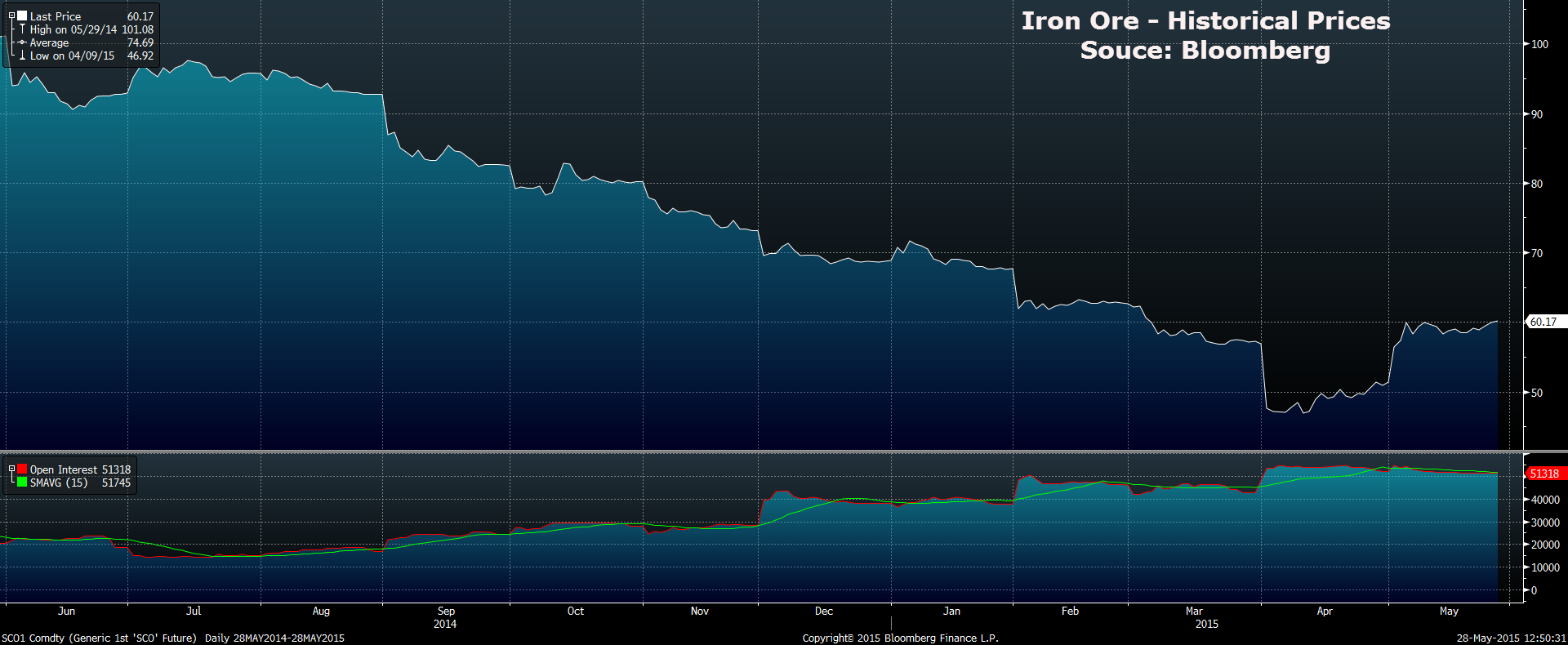The price of iron ore has continued to be driven lower, mainly through the low cost expansion projects within Australia and Brazil. Prices for the commodity have continued falling from last July’s, high of $94.75/t, to trade currently around the $60.00/t level. This significant fall has placed many of the smaller producers under pressure as well as the Australian government’s tax receipts. Subsequently, the viability of many of the smaller producers is at risk and this has led to a range of voices calling for a change in production strategy.
There is a view, perpetuated by the smaller mining concerns, that a cartel could be created to stabilise prices at a point where all market participants can benefit. Currently, two thirds of the world’s iron ore supply is controlled by three major producers. Accordingly, this alternate view would have the major players fix global iron ore prices at a point which would maximise profits for all within the industry.
In principle, further low cost expansions could be restricted, and prices allowed to stabilise at a higher point. This would potentially allow smaller operators to set prices on a steep curve at a point that would provide economic profits whilst the risk of increased competition or supply.
However, cutting production would likely fly in the face of the continual march towards efficiency within the mining plays. In fact, Goldman Sachs estimates mining efficiency is increasing within Australia, at a rate close to 4.0%/year. These gains in efficiency lead to significantly higher production whilst reducing operating costs and represent a shifting of the efficiency frontier.
Also, coordinating such an agreement amongst the three major participants would be extremely problematic. Historically, such agreements, evident within the oil industry, have been undertaken when there are one or two major competitors within the segment. Adding an additional party to any cartel agreement is likely to significantly complicate any predictive assessment of the competitive outcomes.
However, the elephant in the room is the potential production expansion that exists on the horizon over the next few years. Estimates from GS analysts show secondary tier producers as having nearly 100mt/year of new capacity to introduce within the next two years. Subsequently, any cartel operations would need to factor in the cost of absorbing the additional capacity expansions which are already underway. This is likely to represent a significant cost to any cartel members and would further complicate any predictive supply fixing strategy.
Overall, any move to introduce a cartel to the global iron ore market is likely to face significant problems in implementation. The commodity price is likely to come under increased downward pressure in the coming years as all of the expansion projects by 2nd tier producers come online. In our view, the price is likely to continue to decline back towards the $40/t mark through to 2017 and would be unlikely to lend itself to an implausible cartel strategy.
Risk Warning: Any form of trading or investment carries a high level of risk to your capital and you should only trade with money you can afford to lose. The information and strategies contained herein may not be suitable for all investors, so please ensure that you fully understand the risks involved and you are advised to seek independent advice from a registered financial advisor. The advice on this website is general in nature and does not take into account your objectives, financial situation or needs. You should consider whether the advice is suitable for you and your personal circumstances. The information in this article is not intended for residents of New Zealand and use by any person in any country or jurisdiction where such distribution or use would be contrary to local law or regulation. Knight Review is not a registered financial advisor and in no way intends to provide specific advice to you in any form whatsoever and provide no financial products or services for sale. As always, please take the time to consult with a registered financial advisor in your jurisdiction for a consideration of your specific circumstances.
Recommended Content
Editors’ Picks
EUR/USD regains traction, recovers above 1.0700

EUR/USD regained its traction and turned positive on the day above 1.0700 in the American session. The US Dollar struggles to preserve its strength after the data from the US showed that the economy grew at a softer pace than expected in Q1.
GBP/USD returns to 1.2500 area in volatile session

GBP/USD reversed its direction and recovered to 1.2500 after falling to the 1.2450 area earlier in the day. Although markets remain risk-averse, the US Dollar struggles to find demand following the disappointing GDP data.
Gold climbs above $2,340 following earlier drop

Gold fell below $2,320 in the early American session as US yields shot higher after the data showed a significant increase in the US GDP price deflator in Q1. With safe-haven flows dominating the markets, however, XAU/USD reversed its direction and rose above $2,340.
XRP extends its decline, crypto experts comment on Ripple stablecoin and benefits for XRP Ledger

Ripple extends decline to $0.52 on Thursday, wipes out weekly gains. Crypto expert asks Ripple CTO how the stablecoin will benefit the XRP Ledger and native token XRP.
After the US close, it’s the Tokyo CPI

After the US close, it’s the Tokyo CPI, a reliable indicator of the national number and then the BoJ policy announcement. Tokyo CPI ex food and energy in Japan was a rise to 2.90% in March from 2.50%.
